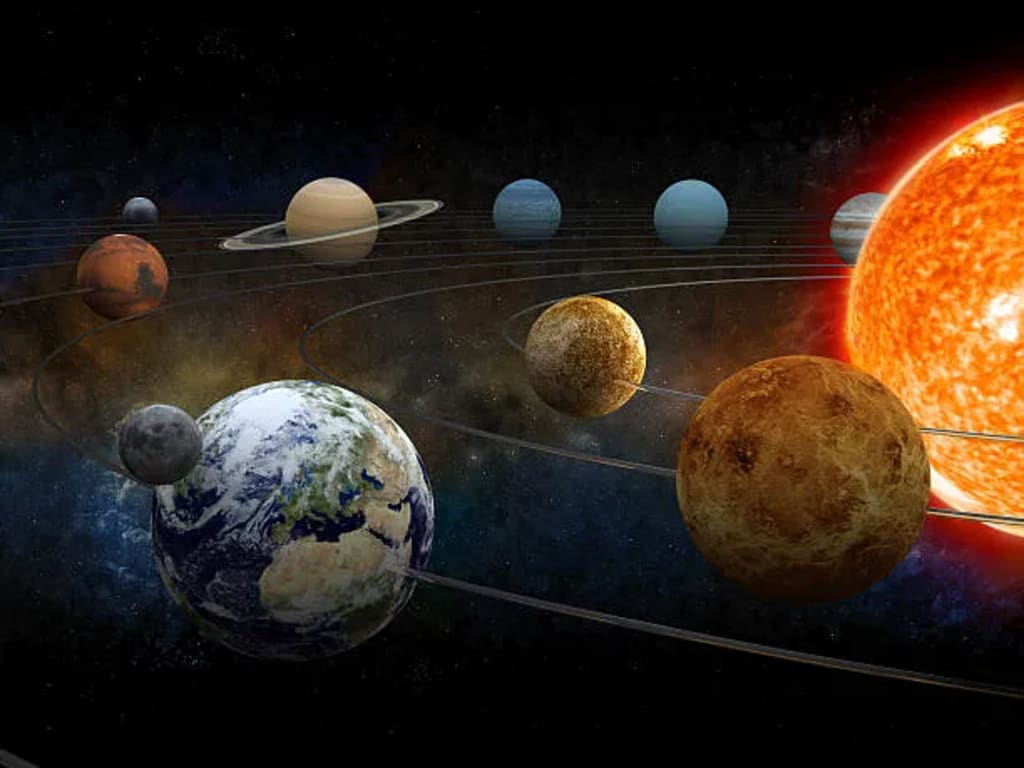Solar System From Another Perspective
Beauty Of Space

You likely have aspirations of exploring the depths of outer space, but there are numerous fascinating occurrences taking place within our solar system that you may not be aware of. For instance, were you aware that Pluto possesses ice-spewing volcanoes, there is a potential colossal planet located beyond Neptune, and Mars is home to a colossal canyon comparable in size to the United States?
First and foremost, let us examine our sun more closely. It is incredibly massive, accounting for 99.86% of the entire mass of the solar system, primarily composed of hydrogen and helium. The remaining 0.14% primarily consists of the mass of the solar system's eight planets (including the one I inhabit!).
Although you may not have noticed, we reside within the sun's atmosphere, which extends far beyond its visible surface. Our planet lies within its grasp, and it is the gusts of solar winds emanating from the sun that give rise to the awe-inspiring phenomenon of the auroras, both in the northern and southern regions.
The solar system is an astounding 4.6 billion years old, as scientists have determined through the study of the oldest available material, meteorites. Furthermore, it is incredibly vast - one would need to travel a staggering 11 billion miles away from Earth to depart from it.
Were you aware that Uranus rotates on its side, and astronomers remain perplexed as to how the planet acquired such an unconventional orientation? The culprits may be ancient, immensely powerful collisions, but this remains merely a theory at present.
Jupiter's ocean surpasses any other found on the planets within the solar system in terms of size, yet it is not the type of ocean one might envision. Jupiter's ocean is composed of metallic hydrogen, and its depth is an astonishing 25,000 miles - nearly equivalent to the circumference of Earth!
Volcanoes on Earth differ from those on Pluto - while our planet boasts scorching hot lava-spewing volcanoes, those on Pluto emit ice! When frozen water expands, immense pressure accumulates until the ice eventually erupts, giving rise to a new "cryovolcano." As you may recall, Pluto was once classified as a planet, but it was reclassified as a dwarf planet in 2006. Astonishingly, this celestial body has a diameter smaller than that of the United States, measuring only 1,470 miles across!
Even if one is a diminutive celestial body, it is still possible to possess a moon of its own. In 1993, during its journey, the Galileo probe encountered a miniature asteroid that was merely 20 meters in size, and to everyone's surprise, it was accompanied by a moon that was 10 meters wide. Since then, scientists have made numerous discoveries of moons orbiting minor planets within our solar system.
Jupiter's moon, Io, is in a constant state of chaos due to the presence of hundreds of active volcanoes on its surface. If one were to visit this extraordinary place, one would witness the smoke billowing high into Io's atmosphere from these volcanoes at any given moment.
Interestingly, here on Earth, it is possible to stumble upon a rock that originated from Mars! After analyzing the chemical composition of certain meteorites found in various locations such as the Sahara Desert, Antarctica, and other parts of our planet, scientists have determined that many of them have their origins on the red planet.
In numerous science fiction movies set in space, the protagonist often finds themselves inadvertently trapped within an asteroid belt, desperately trying to navigate through countless rocks that pose a threat to their spacecraft. However, this portrayal is far from reality. The only known asteroid belt is situated between Mars and Jupiter, containing thousands of asteroids. Nevertheless, the vast distances between these asteroids make the chances of collision almost negligible.
Beyond the orbit of Neptune lies the enigmatic Kuiper Belt, which is filled with massive icy objects. The most intriguing aspect of this celestial formation is the unexplained pattern of its movement. Scientists have proposed that Neptune may be concealing a colossal planet from our view, which has been tentatively named "Planet 9." However, we must patiently await confirmation of its existence.
Lastly, it is worth noting that water is abundant throughout the solar system. Perhaps someone should take the initiative to clean it up! The spill must be cleaned up! To begin with, water is a common component found in comets and asteroids. Additionally, water can be found on the Moon in shallow craters, on Mercury, and Mars has ice at its poles. The same can be said for smaller celestial bodies in our solar system, such as the dwarf planet series or Saturn's moon Cetus. Astronomers even speculate that Jupiter's moon Europa may harbor life beneath its frozen and fractured surface. Europa likely contains liquid water, which, despite being smaller than Earth, could potentially possess a vast and deep ocean that holds twice as much water as all the oceans on our planet combined.
Now, you may already be aware that Mercury is the smallest planet in our solar system and is also incredibly dense, second only to Earth in terms of density. However, this diminutive planet is becoming even smaller and denser. After the messenger spacecraft completed its initial orbital mission at Mars and mapped the entire planet, astronomers discovered that Mercury is highly likely to be a tectonically active world. Its surface features cliff-like formations known as relatively small fault scarps. This leads scientists to believe that these formations appeared relatively recently, indicating that the planet may still be undergoing contraction.
Let us now turn our attention to Saturn's magnificent rings. The existence of these rings has been known since the 1600s when the first telescopes were invented. However, did you know that every outer planet in our solar system - Neptune, Uranus, Saturn, and Jupiter - possesses its system of rings?
Speaking of the outer planets in our solar system, let us delve into the wonders of Neptune. This icy giant is approximately 30 times farther from the Sun than our home planet, resulting in less light and heat received from our star. Surprisingly, Neptune emits a significantly greater amount of heat than it absorbs. If we compare Neptune to its neighboring planet Uranus, despite Uranus being closer to the Sun, it emits nearly the same amount of heat as Neptune. Astronomers have yet to determine the cause of this phenomenon.
Miranda, one of Uranus's moons, stands out as an extraordinary celestial body in the outer solar system. Its surface is adorned with craters, sharp ridges, and other peculiar disruptions. Typically, such features are attributed to volcanic activity, but Miranda's small size makes it incapable of generating the immense heat required. Astronomers propose that the gravitational force exerted by Uranus may be responsible for heating and distorting Miranda's surface. However, this remains a mere theory, and the notion of Miranda having a sibling moon named Lynn Manuel is entirely unfounded.
It is worth noting that our solar system is not the sole inhabitant of the Milky Way galaxy. Quite the contrary, our galaxy is home to an astonishing number of over 100 billion solar systems. Considering this vastness within our galaxy, one can only imagine the expanse of the entire universe.






Comments (1)
Super!!! Excellent story!!!